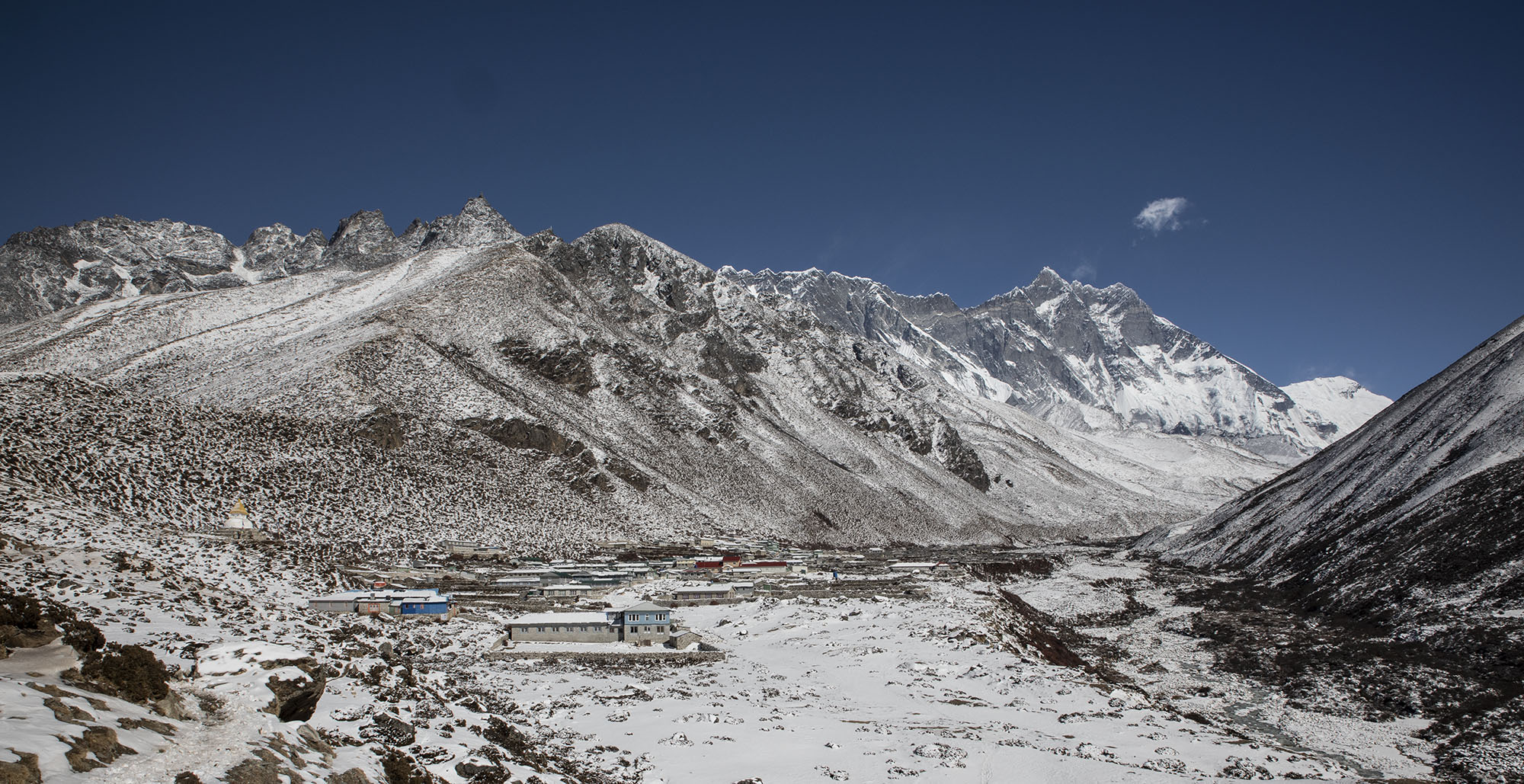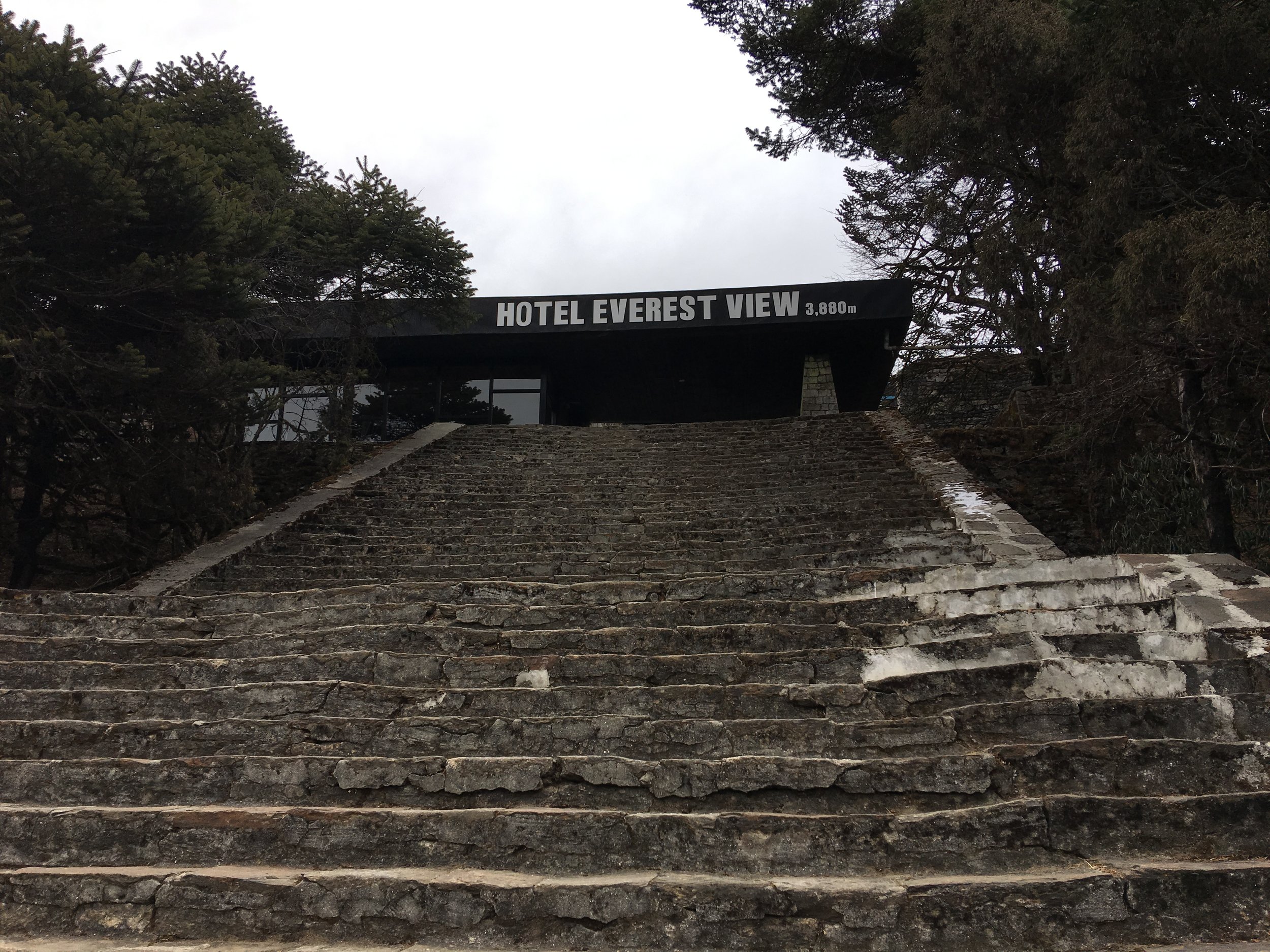I downed two Panadol and settled in for the night, eager to be on that final leg to EBC.
Sometime in the night I awoke needing to pee (the cold made me pee all the time and it drove me nuts having to get out of bed several times every night - the energy expenditure was massive in order to accomplish this menial task and I would come back to bed with my heart rate pounding out at least 150-160bpm).
I got up and was immediately hammered with a headache again and a bit of vertigo. As I moved towards the toilet I felt a wave of nausea and wrote it off as a reaction to the gut-ripping odour from the toilet.
With a constant urge to pee, I couldn’t sleep and as the night wore on my head began to pound with an urgency that had me worried. Was I dehydrated? I had been drinking plenty - the recommended amount while at altitude. I used Panadol during the night but found they had little effect - they provided me instead with a sense that at least I was doing something. When morning came after a long painful night, I knew I was in no state to walk to base camp. Jeet came to find me for breakfast, excited about the day ahead and seeing his uncle who owned the teahouse we would stay at, in Gorek Shep, after we had tagged EBC.
“I can’t go Jeet - my head”
He looked shocked.
“Ok well you must sleep and tomorrow will be better. Drink many water” - his response was encouraging although I could sense his disappointment. Ok - I thought - this will pass and I will be sweet for tomorrow. Nothing to worry about here.
As the day wore on my symptoms worsened. I started to feel a stiffness in my neck and as if my head would explode; I felt increasing nausea and vomited frequently and just felt generally awful. I started to think I needed to go down, even back to Thugla, or Periche where the mountain hospital was, but doubted I could walk. I remembered seeing a child descending on horseback somewhere in the region of Pangboche, the family walking behind. I had stopped to chat to the mother who said her son had AMS (acute mountain sickness) and that was the end of their family trek.
I lay in an utter state of misery, the pain in my head becoming un bearable, the room spinning; I could not stand up; my vision was blotchy and my heart felt like it would burst out of my chest.
I wonder if I have altitude sickness/AMS … the thought began to grow in my head along with the pounding pressure. If I do, I need to go down.
For most people, mountain sickness is a self limiting illness, but it can become life threatening.
It is estimated that more than 100 million people per year travel to the hypoxic (reduced oxygen) environments found at altitudes above 2500m and at least 10 to 20 percent of people develop acute mountain sickness at this height. Acclimatisation to altitude involves multiple physiological changes, occurring over days to weeks, which enable individuals to function better in these hypoxic environments. If this natural adaptation is surpassed by the rate of exposure to altitude, acute mountain sickness can occur.
For this reason, “rest days” of walking to a higher altitude and sleeping lower, aid the body’s physiological response to reduced oxygen and encourage a faster acclimation response. I had done everything right. EVERYTHING. Two nights at Namche (with a walk high rest day); two nights at Dingboche, also with a walk high rest day. Not changing more than 500m per day in my sleeping elevation. Taking it slow.
What was going on here?
I did not take diamox due to a kidney condition I have - diamox is a diuretic and my specialists advice was to avoid if possible. Was this the reason? I have since found out from an experienced guide in the Himalayas, that good old aspirin is best - prophylactic - and avoid diamox if possible.
I could feel myself slipping into a weird kind of head space; I lost all sense of time; I vomited a lot; my ears were ringing loudly; the pain in my head was literally driving me crazy; I couldn’t move my head, my neck was so stiff. It started to dawn on me that the only other time I had ever felt like this was when I had meningitis.
I had been unlucky enough to have had it twice in my life - once in Belgium in 1991, and in New Zealand 2001. This was feeling the same. I started to panic. I am in the middle of nowhere, I and I feel as if I have meningitis.
This is not going well!
Sometime in the afternoon I asked to be taken down. I could not stand up, I pee’d myself, I vomited on myself, I was a disgusting train wreck. I didn’t care - I needed to go down straight away.
A helicopter was called. My passport and phone were taken from me.
“Call my Mother - P L E A S E!” I told Jeet there were emergency contact numbers in a notebook in my pack; I at least had enough wits about me to remember that. I told him to get this information and call my mother to call my insurance company.
After what seemed an eternity, a helicopter arrived and a small army of men came to carry me. Someone packed my gear. I remember being carried to the heli and seeing people unloading bags of rice - how odd. I thought this was a rescue helicopter. I had heard of stories of trekkers being fleeced by the heli operators, and I briefly wondered if this was what was happening here too. Where was my passport? Did anyone call my mother? Did my insurance company know what was going on? Where the F…..K was I?
I was losing it.
I remember seeing the ground lift away and my dreams of EBC eroding away like the monsoon rains deal to mud. GONE.
What had gone wrong?
My symptoms were like those of meningitis - severe headache, vomiting, stiff neck, aversion to light, dizziness, loss of cognitive function, visual disturbances, unable to walk. Research shows that the brain does swell on ascent to altitude - this is normal for everyone, but those with less cerebrospinal fluid volume (a tighter fit of the brain in the cranium) are more likely to develop cerebral oedema symptoms. So those with less ability to accommodate the increased brain volume are the ones that are more likely to suffer.
HACE (High Altitude Cerebral Edema) is directly related to increased intracranial pressure; in effect, it is like meningitis but due to altitude not a virus or bacteria and it is not the inflammation of membranes that occurs, it is the inflammation of the brain that causes similar symptoms. Since being home, the doctors who I have done the rounds with to sort out the various challenges I brought back to New Zealand, have suggested that two bouts of meningitis may not have done me any favours - when ascending, my poor old brain had no where to go due to reduced cerebral spinal fluid (which may be related to my meningitis illnesses), and bingo.
How could I prevent this from happening again?
Don’t ever go to altitude again? Probably sensible. But, I want and need to finish this. Next time, it has been suggest I take even longer than the suggested trekking times, so instead of one rest day I would take two and to limit my rest day acclimation climbs to no more than 500m in elevation change. In Dingboche, I went from 4410 to 5180m on my acclimation day climb; even though I slept at 4410m, the ascent that day may have been too high. Take aspirin? Yes. Next time for sure.
So what happened with my insurance?
I eventually saw my passport and phone again - given back to me at Kathmandu domestic terminal where I was taken to pay the helicopter bill (with my credit card). No they had NOT called my mother or my insurance company, as requested. The evacuation cost me just over $8000 NZD. There was some dispute over who was in the helicopter with me (I didn’t have a clue - I was out to it!), and my insurance company were vary careful before paying out - even then I did not get all my money back and it took over a month. Thats a whole story on its own which may be worth telling for novice travellers! They were however, (insurance) very good at getting me to hospital for tests, CT scanning and paid for my flight back to NZ which they booked and sorted for me. I left Nepal three weeks earlier than planned.
Health outcomes?
I have ongoing headaches, regular attacks of dizziness, increased ringing in my ears but the main issue was my right eye vision loss which was temporary but scary none-the-less. I find it hard to concentrate, I get tired easily, my vision has deteriorated.
I learnt a lot from that experience. I came out of hospital and had a few days relaxing with my very good friend Amanda at her guesthouse above the smog in Changu Narayan. I tired quickly and slept, and generally took it slowly. I found I was less tolerant of the noises, smells, people - the things I loved about Nepal were attacking my senses. I found it almost unbearable. It was a relief to leave and go back to New Zealand. I KNEW I was really sick, when I felt it a relief to board that plane - I LOVE Nepal, and would never normally want to leave.
I arrived back in NZ facing having to shift houses and start a new job. I was struggling physically and emotionally and felt extremely alone. I had packed all my contents into the garage of my old house (where my son was now living), before I had left NZ for Nepal, on my own, but now I needed help more than ever to set up in Fairlie, some three hour drive north and inland of Dunedin. Once again, I shifted my life, alone, as I had done a gazillion times before - but this time I needed help. Help never came. It really hit me that I was truly on my own and that if I had died up there in the Himalayas, my family would have been affected by it, but certainly no one else. The experience up in those beautiful hills has changed my outlook a LOT. I am taking no bull from people; I am choosing who to spend my time with, and I am putting my energy into my family.
The experience has also made me realise there is more to life than
sleep, eat, work, repeat.














































































































































